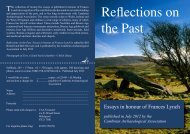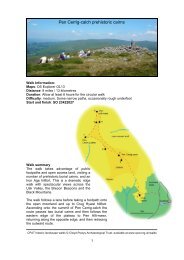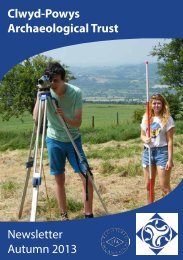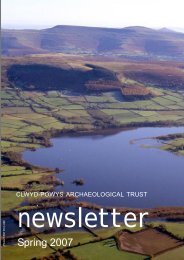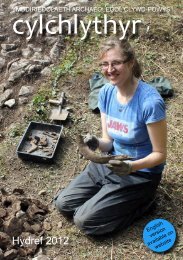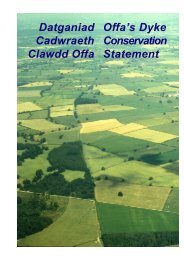Eglwyseg - Clwyd-Powys Archaeological Trust
Eglwyseg - Clwyd-Powys Archaeological Trust
Eglwyseg - Clwyd-Powys Archaeological Trust
Create successful ePaper yourself
Turn your PDF publications into a flip-book with our unique Google optimized e-Paper software.
<strong>Eglwyseg</strong> Mountain – a landscape of prehistoriccairns and later industryWalk Information:Maps: OS Explorer 256Distance: 5.3 miles / 8.5 kilometres (linear) or up to 9.6 miles / 15.5 kilometres (circular)Duration: Allow at least 7 hours for the circular walkDifficulty: medium. Some moderate exposure to drops and one steep descentStart and finish: The walk can be done as a linear route from the car park at World’sEnd SJ 23214835 to the Panorama walk at SJ 24104295, or as a circular walk fromWorld’s End.Walk summaryThe walk takes advantage of publicfootpaths, waymarked permissive pathsand open access land, visitingprehistoric burial cairns and the remainsof past industrial activity, all within aspectacular landscape of limestone cliffsand open moorland.The circular walk starts at World’s End,following a waymarked path aroundCraig y Forwyn before leading along thetop of the spectacular cliffs of Creigiau<strong>Eglwyseg</strong> and passing two prominentburial cairns. The views are extensive,across the Vale of Llangollen and to theBerwyns beyond and, on a clear day, asfar as Snowdonia. The return routefollows a tarmac road before taking theOffa’s Dyke Path below the cliffs.CPAT historic landscape walks © <strong>Clwyd</strong>-<strong>Powys</strong> <strong>Archaeological</strong> <strong>Trust</strong>: available at www.cpat.org.uk/walks1
<strong>Eglwyseg</strong> Mountain – prehistoric cairns and later industryIntroductionThe Vale of Llangollen presents aremarkable visual combination of starknatural landforms and ancient andmodern man-made features.Geomorphologically the vale is a broadrift valley, dominated on the north by thetowering limestone cliffs of <strong>Eglwyseg</strong>Mountain.This area has a wealth of archaeologicalsites, the earliest of which are thenumerous burial and ritual monumentsdating from the Bronze Age (2,300 –1,200 BC), which are scattered acrossVale of Llangollen, Dinas Brânand <strong>Eglwyseg</strong> Mountainthe moor on ridge tops or on hill scarps. The most numerous are the stone-built burialcairns which are typical landscape features of the Welsh uplands and would have beenerected over inhumations (usually single skeletons) and, sometimes, cremations.Others take the form of a stone ring-bank or stone circle. There is no associatedsettlement evidence of this period and it seems likely that the monuments areconnected in some way with the exploitation of upland summer grazing.Overlooking Llangollen from the NE are the imposing remains of Castell Dinas Brân, amedieval masonry castle located within the earthworks of an earlier, Iron Age, hillfort.The Cistercian abbey of Valle Crucis lies to the north of Llangollen, and was foundedby Madog ap Gruffydd in 1201 as a colony of Strata Marcella Abbey, near Welshpool.The landscape also bears the scars of an industrial past. The limestone cliffs of<strong>Eglwyseg</strong> have been quarried for centuries, both for building stone and as a source oflime. Extensive earthworks associated with lead mining are often encountered on theupland plateau. These are mostly in the form of shallow shafts and spoil heaps.The heather moorland has been managed for grouse shooting intermittently since the19 th century, and administered from the Wynnstay estate’s Mountain Lodge on theeastern side of the moor.The WalkFrom the car park at World’s End turnleft and walk along the road for a shortdistance, taking the first track on theright. Continue until it joins anothertrack, where you turn right along awaymarked route. This passes theearthworks of 18 th or 19 th -century leadmining (1) (SJ 23794768), comprisingsmall shafts surrounded by spoil whichare part of a much wider mininglandscape extending across <strong>Eglwyseg</strong>and Ruabon Mountains to Minera.Following the waymarked path, turnright, opposite the cliffs of Craig yForwyn, which is popular with climbers.Follow the path alongside a fence and atOld lead mining shaftCPAT historic landscape walks © <strong>Clwyd</strong>-<strong>Powys</strong> <strong>Archaeological</strong> <strong>Trust</strong>: available at www.cpat.org.uk/walks2
<strong>Eglwyseg</strong> Mountain – prehistoric cairns and later industrythe corner take the waymarked path on the left. Below you will see Plas Uchaf, themanor house at World’s End which you will pass later on.Continue towards the rocky outcrop of Craig Arthur, with views west to the HorseshoePass and its slate workings visible on the skyline. On a clear day the mountains ofeastern Snowdonia can be seen in the distance. At the waymark ignore the descendingpath and keep to the top of the crag.At Craig Arthur there is a good view ofthe limestone cliffs to the south and theBerwyn Mountains on the skyline. Ashort detour ascends the limestonecrags on the left (no path) to animpressive burial cairn (2) (SJ22344708). This is one of many burialsites in the area which date from theBronze Age (2300 – 1200 BC). Thecairn has a kerb of larger stones aroundits edge and, although it has not beenexcavated, it is likely to cover a mainburial, possibly within a stone cist(coffin). Nearby is a small satellite cairnwhich may cover a cremation.Burial cairn on Craig ArthurReturn to the path continuing along the crest of the escarpment before descending intoa steep valley, then rising to the top of the crag beyond. Pass a small stone-builtsheepfold (3) (SJ 22304583) on the right, evidence of past landuse when themoorland was used extensively for grazing sheep. As the path descends a large burialcairn is visible on the skyline ahead (it is possible to shorten the walk at this point byfollowing a path down the valley to Bryn Goleu). Follow the path up the valley, takingthe waymarked path on the right to the large Bronze Age burial cairn (4) on thehighest point of Creigiau <strong>Eglwyseg</strong> (SJ 22184495). An urn and cremation werediscovered here in 1879, placed within in a small chamber.Continue through the gate and followthe path along the top of cliffs, withspectacular views of Dinas Brân and theVale of Llangollen beyond. This steepsided hill rises spectacularly out of thevalley floor and is topped by thepicturesque ruins of Castell Dinas Brân(5), a medieval castle sited within theearthworks of an Iron Age hillfort. Thecastle was built during the 1260s, byGruffudd ap Madog, lord of <strong>Powys</strong>Fadog, most probably at a period ofalliance with the Welsh prince, Llywelynap Gruffudd. The castle was relativelyshort-lived and was burnt by its WelshCastell Dinas Brândefenders in 1277 against an Englishattack. Although it was briefly held by English forces it was finally abandoned soonafter the Edwardian conquest of 1282.CPAT historic landscape walks © <strong>Clwyd</strong>-<strong>Powys</strong> <strong>Archaeological</strong> <strong>Trust</strong>: available at www.cpat.org.uk/walks3
<strong>Eglwyseg</strong> MountainMaps Ordnance Survey Explorer 256Distance 5.3 miles / 8.5 kilometres (linear) or up to 9.6 miles / 15.5 kilometres (circular)Duration Allow at least 7 hours for the circular walkDifficulty Medium, with some moderate exposure to drops and one steep descentStart/finish The walk can be done as a linear route from the car park at World’sEnd SJ 23214835 to the Panorama walk at SJ 24104295, or as a circular walkfrom World’s End.From car park turn left and take first track on right, continuing until itjoins another track, where you turn right along a waymarked route. Thispasses the earthworks of 18th or 19th-century lead mining 1 (SJ23794768), comprising small shafts surrounded by spoil which arepart of a much wider mining landscape. Following waymarked path,turn right, opposite the cliffs of Craig y Forwyn, which is popularwith climbers.Follow path alongside fence and at the corner take waymarkedpath on left. Below you will see Plas Uchaf, the manor house atWorld’s End which you will pass later on.Continue towards the rocky outcrop of Craig Arthur, withviews west to the Horseshoe Pass and its slate workings visibleon the skyline. At the waymark ignore descending path andkeep to top of the crag.At Craig Arthur there is a good view of the limestone cliffsto the south and the Berwyns on the skyline. A short detourascends the limestone crags on the left to an impressive burialcairn 2 (SJ 22344708). This is one of many burials sites in thearea which date from the Bronze Age (2300 – 1200 BC). Thecairn has a kerb of larger stones around its edge and although it hasnot been excavated it is likely to cover a main burial, possibly within astone cist (coffin). Nearby is a small satellite cairn which may cover acremation.Return to the path, continue along crest of the escarpment, descend into a steepvalley and rise to the top of the crag beyond. Pass a small stone-built sheepfold 3 (SJ22304583) on right, evidence of past landuse when the moorland was used extensively forgrazing sheep. As the path descends a large burial cairn is visible on the skyline. Follow the pathFor a fuller description of this walk see www.cpat.org.uk/walksup the valley and take the waymarked path on right to the large BronzeAge burial cairn 4 on the highest point of Creigiau <strong>Eglwyseg</strong> (SJ22184495). An urn and cremation were discovered here in 1879,placed within in a small chamber.Continue through gate and follow path along top of cliffs,with spectacular views of Dinas Brân. This steep sided hillrises spectacularly out of the valley floor and is topped by thepicturesque ruins of Castell Dinas Brân 5, a medieval castlesited within the earthworks of an Iron Age hillfort. The castleis thought to have been built by Gruffydd ap Madoc, son of thefounder of Valle Crucis Abbey.The path curves into the head of a valley to a signpost 6 (SJ22554420). There are now several options. To follow the walk as alinear route take the Panorama Walk as far as the road, then turn leftand follow the road to the parking area (SJ 24104295). For the circularroute either continue along the Panorama Walk to the road (SJ 23644324).Alternatively, descend directly to the right from the signpost on a narrowpath, keeping the wall on your left. This path descends steeply, is roughunderfoot, and may be difficult in wet weather. As the valley narrows ignorea path leading left to a quarry and follow the path right, through gorse, to theroad.Turn right at road and and follow it for some distance before taking a trackrising on the right, waymarked for the Offa’s Dyke Path (SJ 21814530). Avery short detour on the right leads to a well-preserved limekiln 7. Thisarea was once an important source of limestone, which was used as abuilding stone and also burnt for use in lime mortar and as an agriculturalfertilizer.Continue to follow the Offa’s Dyke Path along the base of the cliffsand below Craig Arthur. Take left fork signed for Offa’s Dyke Path,which gives views of Plas Uchaf 8. The impressive timberframedmanor house bears a date of 1563 and stands on the site ofa hunting lodge of the princes of <strong>Powys</strong>, established by Bleddynap Cynfyn in the 11th century. Legend relates that here Owain apCadwgan abducted Nest of the kingdom of Dyfed.Continue through a felled plantation to join the road on a cornerwith a ford. Cross the ford on stepping stones and follow the roadback to the carpark, noting a limekiln 9 on the right.CPAT historic landscape walks © <strong>Clwyd</strong>-<strong>Powys</strong> <strong>Archaeological</strong> <strong>Trust</strong>



